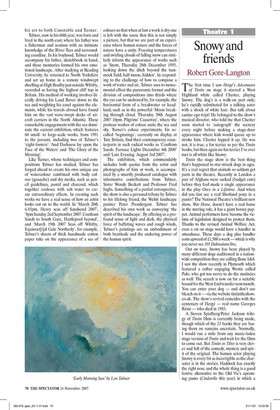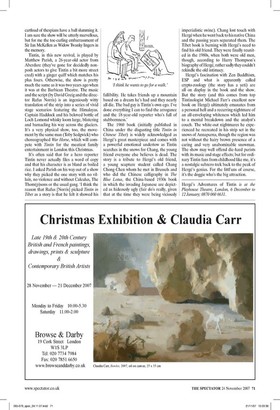Snowy and friends
Robert Gore-Langton rr he first time I saw Herge's Adventures of Tintin on stage it starred a West Highland white called Chester, playing Snowy. The dog's is a walk-on part only; he's rapidly substituted for a talking actor with a shock of white hair. But talk about canine ego-trips! He belonged to the show's musical director, who told me that Chester soon started to 'autograph' the scenery every night before making a stage-door appearance where kids would queue up to stroke him Chester lapped it up. He was not, it is true, a fox terrier as per the Tintin books, but then again no fox terrier I've ever met is all white like Snowy.
Tintin the stage show is the best thing that's happened to star-struck dogs in ages. It's a real regret that animals so seldom get parts in the theatre. Recently in London a pair of Afghans were sacked (budget cuts) before they had made a single appearance in the play Once in a Lifetime. And when did you last see a real Shetland pony in a panto? The National Theatre's brilliant new show, War Horse, doesn't have a real horse in the starring role, it has a giant horsey puppet. Animal performers have become the victims of legislation designed to protect them. Thanks to the revised Animal Welfare Act, even a rat on stage would have a handler in attendance. These days a dog plus handler costs upward of £1,500 a week — which is why you never see 101 Dalmatians live.
Out on tour, Snowy has been played by many different dogs auditioned in a nationwide competition they are calling Bone Idol. I saw the show recently in Plymouth which featured a rather engaging Westie called Polo, who got too nervy to do the matinees as well. The search is now on for a suitable hound for the West End transfer next month. You can enter your dog — and don't use bleach on it —via the website tintintheshow. co.uk. The show's revival coincides with the centenary of Herge — real name Georges Rémi— who died in 1983.
A Steven Spielberg/Peter Jackson trilogy of Tintin films is currently being made, though which of the 23 books they are basing them on remains uncertain. Normally, I would run a mile from any music-laden stage version of Tintin and wait for the films to come out. But Tintin in Tibet is very clever and full of the comedy, mystery and spirit of the original. The human actor playing Snowy is every bit as incorrigible as the character is in the stories. Haddock has exactly the right nose and the whole thing is a good festive alternative to the Old Vic's upcoming panto (Cinderella this year) in which a cartload of thespians have a ball slumming it. I am sure the show will be utterly marvellous, but for me the toe-curling embarrassment of Sir Ian McKellen as Widow Twanky lingers in the memory.
Tintin, in this new revival, is played by Matthew Parish, a 26-year-old actor from Aberdare (they've gone for decidedly nonposh actors to give Tintin a bit more street cred) with a ginger quiff which matches his plus fours. Otherwise, the show is pretty much the same as it was two years ago when it was at the Barbican Theatre. The music and the script (by David Greig and the director Rufus Norris) is an ingeniously witty translation of the strip into a series of vivid stage scenarios featuring the Himalayas. Captain Haddock and his beloved bottle of Loch Lomond whisky loom large, blistering and barnacling his way across the glaciers. It's a very physical show, too, the movement by the same man (Toby Sedgwick) who choreographed War Horse, which will compete with Tintin for the meatiest family entertainment in London this Christmas.
It's often said that for a hero reporter Tintin never actually files a word of copy and that his character is as bland as boiled rice. I asked Parish on his way out of a show why they picked the one story with no villain, no violence and without Calculus, The Thom(p)sons or the usual gang. 'I think the reason that Rufus [Norris] picked Tintin in Tibet as a story is that he felt it showed his fallibility. He takes friends up a mountain based on a dream he's had and they nearly all die. The bad guy is Tintin's own ego. I've done everything I can to find the arrogance and the 18-year-old reporter who's full of stubbornness.'
The 1960 book (initially published in China under the disgusting title Tintin in Chinese Tibet) is widely acknowledged as Herge's great masterpiece and comes with a powerful emotional undertow as Tintin searches in the snows for Chang, the young friend everyone else believes is dead. The story is a tribute to Herges old friend, a young scupture student called Chang Chong-Chen whom he met in Brussels and who did the Chinese calligraphy in The Blue Lotus, the China-based 1930s book in which the invading Japanese are depicted as hideously ugly (fair do's really, given that at the time they were being viciously imperialistic swine). Chang lost touch with Herge when he went back to his native China and the passing years separated them. The Tibet book is burning with Herges need to find his old friend. They were finally reunited in the 1980s, when both were old men, though, according to Harry Thompson's biography of Herge, rather sadly they couldn't rekindle the old intimacy.
Herges fascination with Zen Buddhism, ESP and what is apparently called crypto-zoology (the story has a yeti) are all on display in the book and the show. But the story (and this comes from top Tintinologist Michael Farr's excellent new book on Herge) ultimately emanates from a personal hell and a recurring nightmare of an all-enveloping whiteness which led him to a mental breakdown and the analyst's couch. The white-out nightmares he experienced he recreated in his strip set in the snows of Annapurna, though the region was not without the hairy brown presence of a caring and very unabominable snowman. The show may well offend die-hard purists with its music and stage effects; but for ordinary Tintin fans from childhood like me, it's a nostalgic subzero trek back to the peak of Herge's genius. For the littl'uns of course, it's the doggie who's the big attraction.
Herge's Adventures of Tintin is at the Playhouse Theatre, London, 6 December to 12 January; 0870 060 6631.







































































 Previous page
Previous page